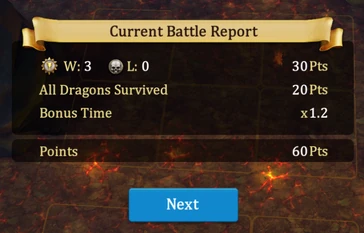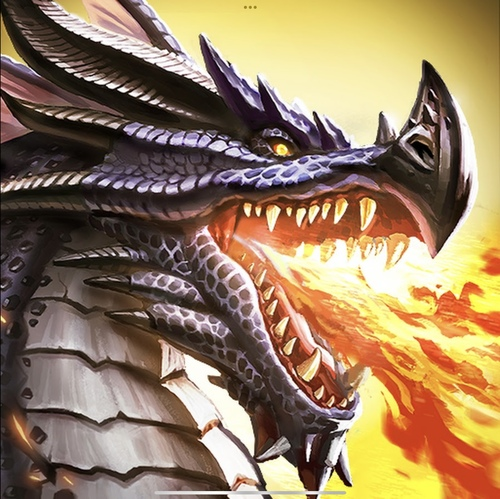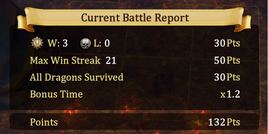The Dragon Battle Ground or DBG is a place for you to face your Great Dragons off against other players’ Dragons.
Unlike the Arena, DBG Ranking is based on points alone. Points are awarded based on wins, win streak and IF all your Dragons survived, not based on the rank of the player you went against. Points are calculated after you have completed all three rounds of your Battle. This is important to know if you are playing till that last seconds. If you do not complete all three rounds you will not be awarded your points in that Tournament.
Each win = 10 points
All Dragons Survived = 10 Points (This is only awarded if all your dragons survived that battle, it does not matter if you lost 1, 2 or 3 Dragons, losing 1 will cost you these points.


Bonus Points: Bonus points are awarded for time and win streaks. You can lose up to 2 dragons and win to keep your streak going.
Win Streak Bonus:
3 Wins = 5 points

6 Wins = 10 points
12 Wins = 20 points
21 Wins = 50 points
51 Wins = 100 Point

Initiative: Who goes first?
This is actually kind of tricky. Although there is a “basic” layout of who goes when, it is not always accurate. Keep these in mind to maximize your initiative are:
Dragon Speed: The no brainer is that your dragon vs theirs, is that whoever is faster goes first. But that is not all, in DBG your team average speed is the biggest thing. 1 dragon with a speed of 1500 and one with a speed of 600 has a team average of 1050. If your opponent has a team speed better than 1050 then they will go first.This is the TEAM average, whether that is 1 Dragon or 3. This is important because as the number of dragons change due to defeat so does the team average. Say your team consists of the Great Dragon, Water Dragon and Nightshade Dragon. Your opponent has Fire Dragon, Earth Dragon and Nightshade Dragon. Your Average speed is 850 while your opponent team speed is 883, your opponent will move first this round. During the round your GD is defeated and you are left with your Water and Nightshade. Your team speed has now changed. Instead of averaging the speed of three dragons you now average just two. Your new team speed is 950 and now you are the faster team so this turn you go first.
From doing studies I have found that each dragon gets a turn based on their placement on the board. the #1 Dragon is the first dragon in the order shown below from 1-6. The fastest team goes with that #1 and then the other teams #1 moves. Then the 1st teams #2 and so on. If a dragon is defeated before it has a turn to go then the next dragon in line will go on that turn. So your #1 kills your opponents on the opening move of that turn, your opponents #2 will assume the #1 turn and the subsequent dragon will take up the #2 spot. If you have ever seen a dragon move twice in a row this is what has happened, that dragon moved last on the last turn and first on the next turn. Normally this happens when a team goes from 2 to 1 dragon and now that 1 dragon is faster that its opponents team. It is now the #1 and takes its turn first.

In this chart No.1 of red goes against No.1 in Blue. When No.1 Blue dies the No.2 Dragon now becomes Blues No.1.
2
|
2
|
1
|
||||||
|---|---|---|---|---|---|---|---|---|
1
|
1
|
X
|
||||||
1
|
2
|
1
|
X
|
1
|
X
|
|||
3
|
2
|
2
|
Speed Dragons are Fire Dragon (FD) and Nightshade Dragon (ND/NSD)
Defense Dragons are Great Dragon (GD) and Earth Dragon (ED)
Healing Dragon is the Water Dragon (WD)
Both teams have 6 placements where they can put a Dragon. These places are a general movement spot but are not always the order used in a round.
Battle Skills: Each dragon has a different skill they use in the DBG.
GD and ED have defensive while ND and FD have offensive and the WD has a team heal.
GD only defends himself but it reciprocates damage back at attackers.
ED throws a wall in front of teammates that absorb some incoming damage. This is most useful when all your Dragons are on the front row.
FD has an Area of Effect (AoE) damage blast that hits all dragons on either the front or rear row, not both and not in line, front to back. This is most useful against multiple dragons on a single row.
ND has a single target multi-hit that deals massive damage. This is best used vs the ED as it tends to have the most health of the Great Dragons.
WD AoE Heal is most useful when you have multiple dragons taking hits.
Dragon Baselines: Dragons utilize armor that can change the stats they have to use against other dragons. You will want to manage this if you are using your dragon outside of the DBG. Armor can consist of all the stats listed on the Dragon stats page, Life, Defense, Melee Attack, Ranged Attack, Range, Speed, and Load. For the DGB you will want to look at your Dragon and determine the best stats to go in with.
GD seems to favor Melee while the ED, FD and ND use Ranged (not range.) The WD may be influenced by Range but I cannot confirm this. Load is useless in the BG as far as I can tell.
Life increases the damage your dragon can take.
Defense mitigates the damage taken from an attack.
Melee Attack is the damage you will deliver on natural hits from the Melee Dragons.
Ranged Attack deals damage the same as Melee.
Speed aids in determining initiative in the BG each turn.
Strategies with Armor:
GD has a good attack and defense, but facing off against a FD you may want to stack up on Life and Defense. This Dragon is in the middle against all other Dragon stats. Pros: Battle skill defends and inflicts damage to attacker. Cons: As slow as the ED as the slowest of all the dragons.
ED has excellent life and can outlive most massive strikes if life and defense is stacked proper. It doesn't hit very hard and stacking this skill doesn't improve it significantly. Speed might also be a burden to this creature as using its battle skill is most useful when multiple dragons are taking hits. This Dragon is an excellent shield when used with the FD and ND combo. Pros: Best Health and Defense. Cons: Slow and does not deal a lot of damage.
FD deals massive damage but is fairly poor in defense. This dragon does not fare well against other FD or ND unless they strike first. Stacking Speed and Ranged Attack may be the best practice here. Although if you can stack Life and Defense on this dragons Armor it may make it more survivable in situations as it still would deal heavy damage. Pros: Devastating Battle skill, 2nd in speed. Cons: 2nd lowest Life and lowest Defense.
ND deals a good amount of Damage and generally has better defense than the FD. This is probably the best dragon in the DBG in solo respect. Pros: Big damage and the fastest of the Dragons, 2nd most Life and Defense. Cons: Unknown...
WD only heals. WD Battle Skill is to heal all teammates and its normal move is to heal a single target. It is unclear what stats affect this Dragons ability in the DBG (recently observed that range may impact this Dragons skill.) Its single target heals seem to be closely related to its battle skills power so boost this if you are using this Dragon. Life and Defense are best stats otherwise as this will allow your WD to stay in the fight longer. (Hint: If you are attacked, if your WD can out heal the incoming damage you can win the battle. You must defeat all enemy dragons to win.) Pros: Heals your wounded dragons. Cons: Does not deal damage!
DBG Dragon Combinations: You can determine who you want in the DBG, but as of now you can only select 3. You may consider your highest level Dragons or your best Armored, but the combination of dragons you use is up to you. Most seen in DBG is GD/FD/WD. Solid alts ED/FD/WD, GD/ND/WD, ED/ND/WD. Mass damage, GD/FD/ND solid alt ED/FD/ND. Hard Defenses, ED/GD/WD.
Strategies in Combat[]
If you are having trouble with a particular group of dragons that you feel you should be able to better against, you can try a few things to see if that helps.
- Move your engagement point. Dragons will attack what is in front of them, on the front line, and then the back line. You may have a dragon taking to much damage that it cannot handle, try moving it to another position on the board.
- Focus down the DPS. The DPS dragons are the Fire and Nightshade Dragons. If one of these dragons are on the front line you may want to stack your dragons to have 2 hit it in place of 1 or none.
- Divert the damage. The three types of dragons are Tank (GD, ED) DPS (FD, NSD) and Healing (WD). Depending on the configuration you use you may want to have your Tank be hit by 2 while either a DPS, Off-tank or Healer takes hits from 1. This spreads out the damage so your dragons can hopefully live longer.
- Go for speed. The ED and GD are slow having the same base speed sub 20. If your opponent keeps moving first try switching out your dragon or armor to be faster.
- The FD finisher! The FD's liner attack can literally change the outcome of a match. If you are facing this dragon you must either kill it quick or hit it less. Killing it before it accumulates 3 bars is optimal as it removes a big threat to your team. If you are unable to kill it quickly change your positioning so you will hit it less and make it take longer before it can use the finisher. Another option is to position your dragons so the one that is in a line of its own is making the killing blows. This will make the FD see that as the biggest threat and attack that one dragon instead of your two on the same line.








